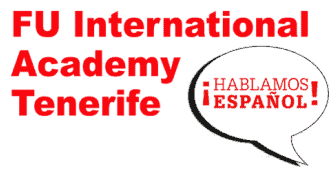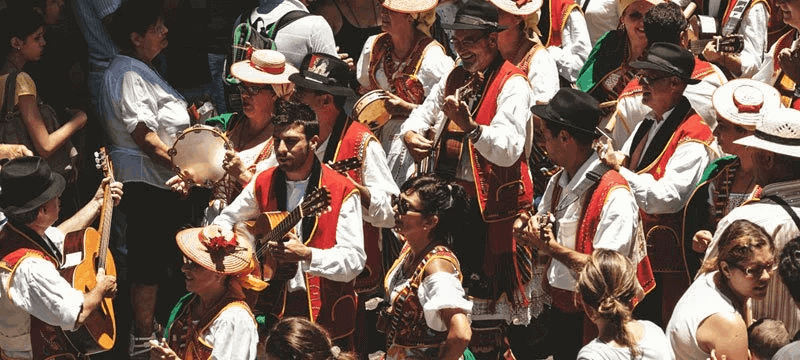
-
Save
A Unique Festival Experience in Tenerife
If you are in Tenerife anytime from April to September consider yourself lucky since this is the season of Romerías – a traditional festival you shouldn’t miss. Romerías are celebrated in many towns all over the island. These celebrations take place at different times so you might be able to visit more than one Romería.
The main action is a huge procession through town. On beautifully decorated carts, people hand out food and wine to the crowd. Some of the carts are pulled by oxen, cows, or even mighty bulls. Herds of goats or sheep also take part in the parade, while the people dress in traditional costumes of all colors.
Music and dance
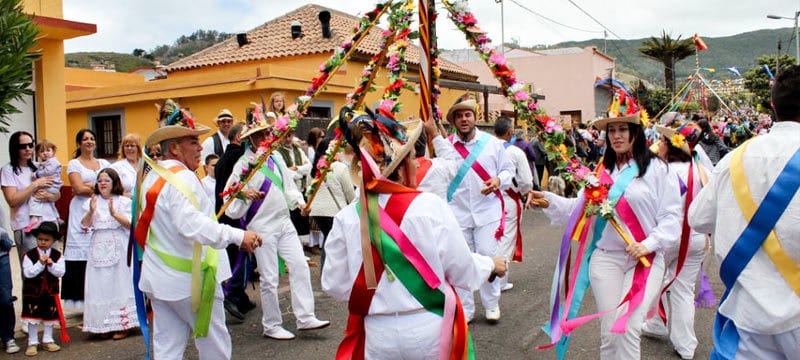
-
Save
There is music and dance everywhere, all of which create a great atmosphere. Spain is known for celebrating fiestas like no other country but Romerías are special and unique events even here.
But what is the history of the festival and how can you prepare for your first visit to a traditional Romeria?
History of Romerías
In its most original sense, a Romería is a religious pilgrimage. The word “Romería” comes from “romero”, which means those traveling towards Rome. It’s a catholic celebration that indicates a peregrination of some sort to the holy site. It doesn’t always have to be a long journey, it can also just be a short walk.
In Tenerife, some towns celebrate to honour a saint who helped them to get a good harvest. That’s why eating and drinking are essential aspects of the festival.
Apparently, it was the upper class that “invented” the Romerías. They gathered to celebrate country life – dressed like farmers, pouring local wine and feasting on goats and beef. In these times a good harvest was believed to be a result of the saint’s good will. Also, the festivals became more popular with the peasants. So the Romerías turned into a religious festival for everybody.
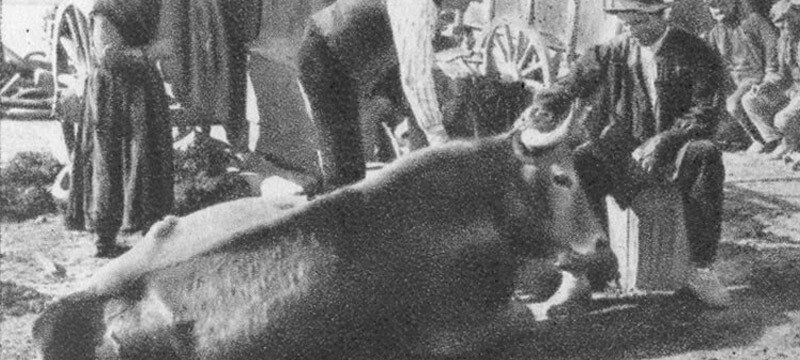
-
Save
The Romería in Garachico has been celebrated since the 17th century. It shows gratitude to Saint San Roque for helping the people there to overcome an epidemic of the plague. Processions in honor of the saints and religious services are still part of the Romería, but nowadays, celebrating and having fun are just as important.
Each town celebrates its own Saint
Most villages or towns in Tenerife celebrate their own Romería once a year. They all honor “their” Saint.
The one in Tegueste honors San Marcos, the celebrations in Los Realejos take place in honor of St Isidro Labrador. Garachico, as mentioned before, pays tribute to San Roque, and St Benedict is honored by the Romería of La Laguna – just to name a few.
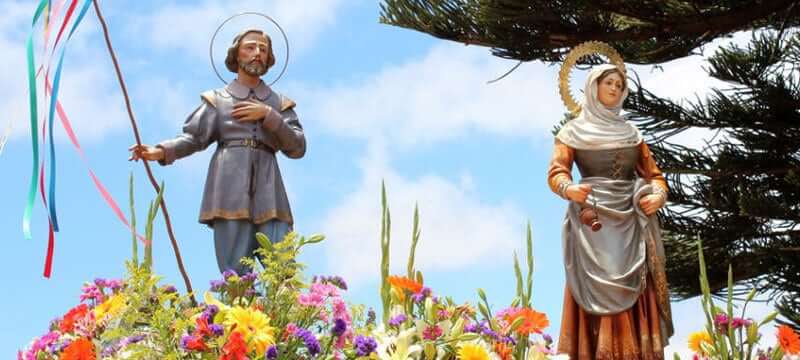
-
Save
About the different Romerías
The start of the festival season is the last Sunday of April. This first Romería of the year is held in Tegueste and is usually the biggest one.
Since the Canarians love their Romerías, they embrace the first opportunity to celebrate and everybody goes to Tegueste. The festival starts with the election of a “Romera Mayor” – who is like a queen of the festival.
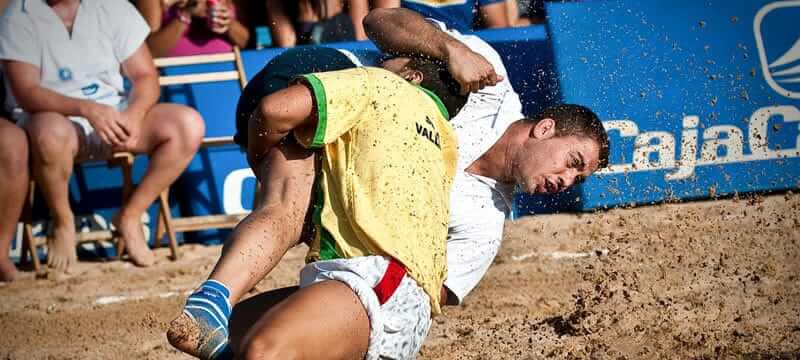
-
Save
In some parts of the island, the celebrations are more like big fairs. Here you get to watch competitions of traditional canary wrestling (“Lucha Canaria”) or basketball. The procession refers to the religious background with all natural produce, livestock, and traditional costumes. Before or after the parade, the priest blesses the livestock and an offering is made to the saint. Don’t worry, the offer is not an animal but usually a range of natural products.
Romerías in the North are typically way bigger than those in the South. For example, Los Realejos and La Orotava hold their Romerías in June. They are not far from Puerto de la Cruz so they are easy to access. Tacoronte and La Laguna are a bit further away but definitely worth the visit. The celebrations here are bigger than in other towns.
Here you also get the spirit of a traditional Spanish fiesta – the positive atmosphere and lighthearted way of life are everywhere.
The most spectacular Romería takes place in Garachico – famous for the stunning and over-the-top decorations of their carts. It’s the season’s highlight for all those who have had the chance to live to see it. The celebration usually takes place in the middle of August.
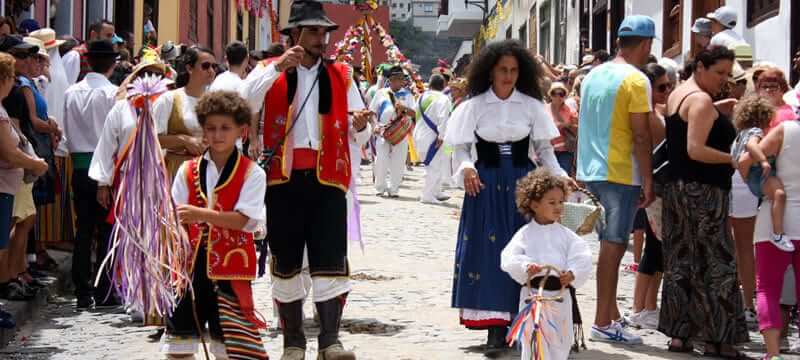
-
Save
Thousands of visitors come to Garachico to escort a figure of the saint San Roque from his church to St Ana in the center of town. After a religious service, the procession starts around 1 p.m. and in a huge parade, the figure is taken back to its church. All carriages are adorned festively as are the goats and oxen which are part of the parade. Along the coastline, the fishermen of Garachico also follow the ceremony in their boats.
Baile de Magos
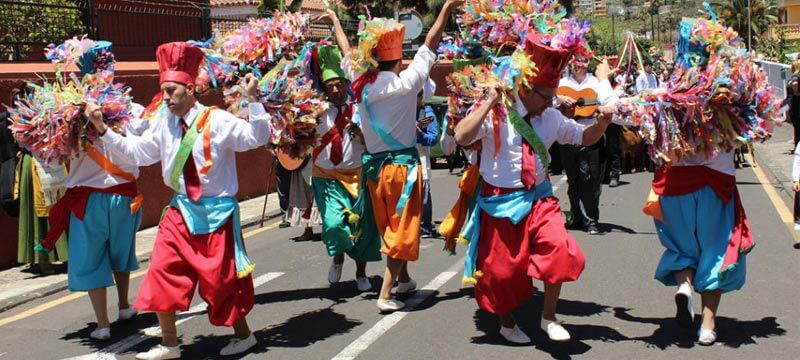
-
Save
The “Baile de Magos” (approx. “Workers Dance”) is another traditional event. It usually takes place on the Sunday before the Romería in each town. It’s a dance event with traditional music where people are dressed in traditional clothes and participate in traditional dances.
If you are out for that cultural experience, you shouldn’t miss the “Baile de Magos“. But don’t forget to rent or buy a traditional outfit. Read below how to get ready for your first Romería visit.

-
Save
Stay informed and never miss a beat!
Sign up for our newsletters and receive the latest updates on Tenerife and Spanish learning content. Plus, be the first to know about exciting news, events and exclusive deals in Tenerife. Subscribe now and make the most of your Tenerife experience!
Five Useful Tips to Prepare for Your First Romería
1. Traditional clothing
At the Romerías people dress in traditional clothing. Each town has its own traditional costume differing slightly in colors and design. But no worries, they will still let you in even if you are wearing the costume of another town or no costume at all.
Most locals have their own costumes in the colors of their town and will wear it to every Romería they attend, proudly representing their town.
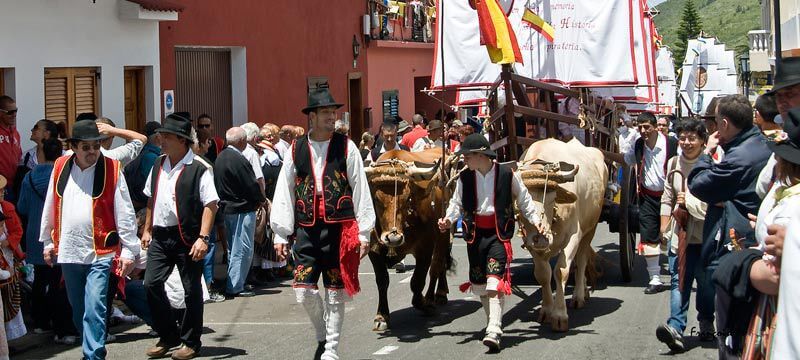
-
Save
If you want to have the full experience and show up in traditional clothing, just rent the costume of your choice. There is a store for that in each town. Here you have two options but there are more:
- Los Calados en La Laguna
- Artesanía Islas Canarias in Los Realejos
If you are uncertain about how to put on the traditional fajin – the sash – that men usually wear, watch this video:
Note that even if you choose to show up in plain clothes, you will still be included in the festivities – and there will be lots of wine for you too 😉
2. Wine and food
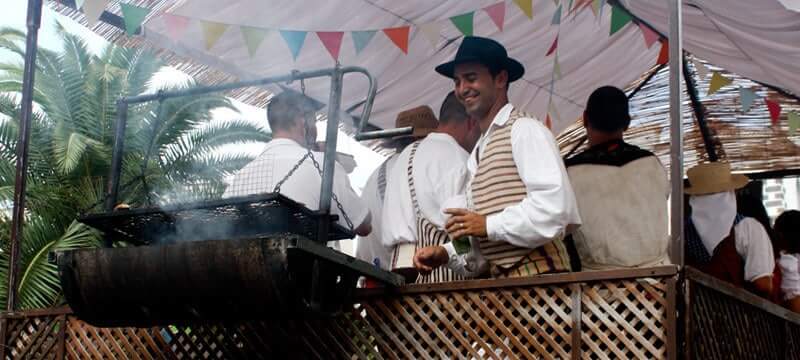
-
Save
Talking about wine – there will be a lot of that. Being a harvest festival, food and wine are an essential to any Romería. And it’s all for free – otherwise it’s not a Romería. The procession is the highlight of the festival. Beautifully decorated carts, dancers, musicians and even goats, oxen or cows parade through town – right through the huge crowd of visitors waiting on both sides of the path. And there’s a good reason why they are waiting for the parade to pass other than to just watch it.
The folks on the carts are giving away food for free. And when we say food, we mean popcorn, hardboiled eggs, potatoes and bread as well as barbecued steaks! No joke, some of the self-built wooden carts have barbecuers on them and, trust us, they know what they’re doing with that meat.
Of course, the hot and juicy goods that come directly from the barbecuer are the most wanted ones. So don’t go there on an empty stomach expecting to be fed ounces and ounces of meat. But do get in the crowd, stick out your hands and see what you can get. It’s a fun experience!
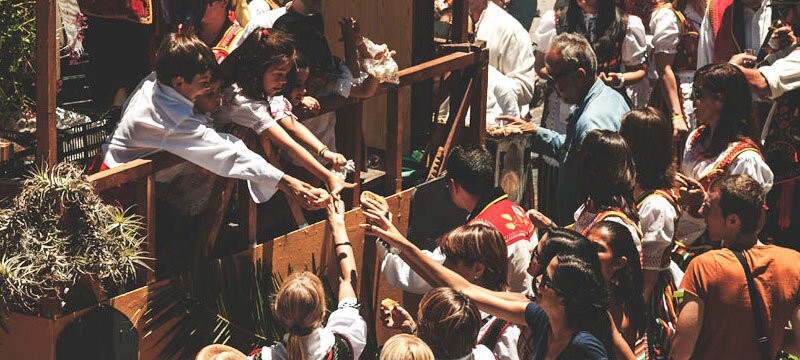
-
Save
Another reason why you shouldn’t go to a Romería on an empty stomach is because of the amount of wine that you’ll be drinking. Along with food, the people on the carts hand out wine. Which leads us to the most important step in preparing for your visit – buy a Vaso de Romería (“Romería glass”).
It’s a small glass in a leather case with a string on it to hang around your neck. You’ll be wearing your wine glass as a necklace. How genius is that?
You can either buy your glass at various local stores beforehand. Or you can get them directly at the Romería at one of the stands. These stands, also offer a huge variety of souvenirs. At other stalls you get drinks and food – in case you are craving something more in the unlikely event that you are still hungry. Fact is, you will neither be hungry nor thirsty.
3. Happy and peaceful crowd
You might think that all that wine and so many people sometimes lead to aggressive situations but let us assure you that this is not the case at Romerías. The people don’t go there to get drunk. They go to celebrate an old tradition together with their entire family.
You will be surrounded by light-hearted people of all ages having a good time. They’ll be smiling, laughing, singing and dancing. In our opinion, there’s no safer festival to attend than one of the Romerías.
The people there are all kind and friendly. They’ll welcome you to experience their rich tradition and culture with them and all they want is for everybody to have a good time. If you don’t believe it, remember that some of them are giving away barbecue steaks for free. That speaks for itself?
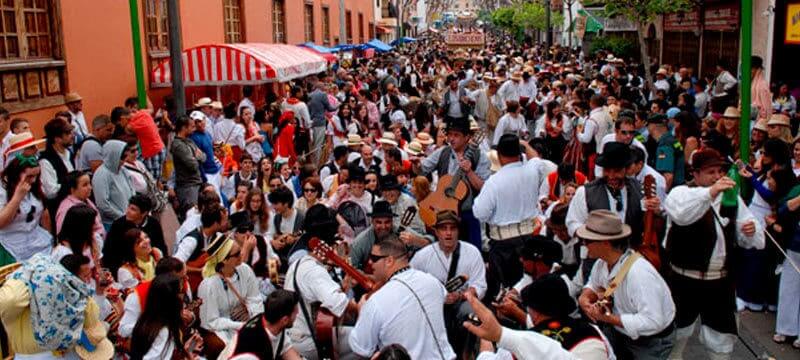
-
Save
4. Ongoing celebrations
The main event of the Romería is the huge parade through town. That usually lasts two or three hours. You don’t have to be shy and watch from the distance. The Canarians are happy to celebrate with you. So get into the crowd and watch the animals, the carts, the food pass right next to you. You won’t regret it.
The parade will proceed into a big party. Filled with people talking, laughing and dancing in the street. In most towns, there’s at least one stage with live music. This is where most people gather. The stands stay open until the party ends – and when it ends is up to the people. It’s a typical Spanish fiesta by all means.
5. How to get there and back
Well, all great things usually have an obstacle: How do you get back from the Romería after all that wine you had to drink? Don’t worry, there are usually plenty of options to go by bus. The local bus service Titsa schedules extra trips to the Romerías.
So let’s say you are staying in Puerto de la Cruz and want to go to the Romería in Tegueste, there will be 2 to 5 buses departing from Puerto de la Cruz in the morning at different times.
Just take your pick. Same thing when you’re going back. Return to the drop-off point and catch one of the buses going back to your town. Just ask anybody from Titsa bus service when the last bus will be leaving.
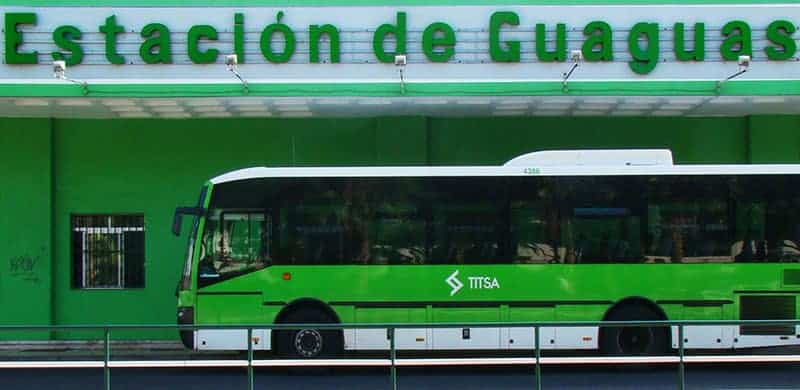
-
Save
If you choose to take one of the unscheduled buses especially for the Romería, make sure you book tickets in advance. We recommend you to do so as the normal buses will be packed and will take longer since they’re stopping at every bus stop (Check Titsa website for schedules here).
If you can find a designated driver amongst your group, be prepared to park your car 2-3 kilometers out of town and go on a rather long walk. As soon as you see cars parked on the side of the roads (where they are probably not supposed to park), you know you are there. It’s very unlikely you won’t find a parking space any closer since no one leaves a Romería early. Find a spot there and walk the rest of the way.
Now that you know everything you need to be prepared for your first Romería, check the dates for 2022 here to see which one will take place while you’re here. Be part of this beautiful Canarian tradition and take it all in.
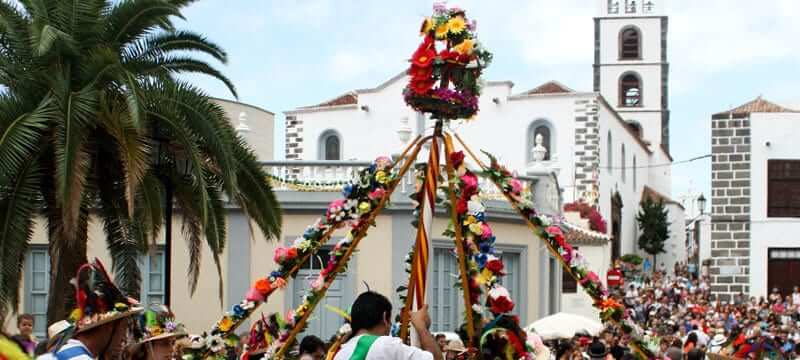
-
Save
